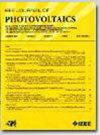光伏组件层压中温度曲线和交联的模拟与实验分析
IF 2.5
3区 工程技术
Q3 ENERGY & FUELS
引用次数: 0
摘要
层压工艺对光伏(PV)组件的长期可靠性起着至关重要的作用。监测组件中封装材料的交联程度有助于确保层压工艺的质量,而层压工艺受层压温度和工艺时间等因素的影响。层压过程中一致的垂直温度分布对于实现整个组件深度的均匀交联非常重要。本研究通过热电偶测量来获得温度曲线,并评估有电池片和无电池片的玻璃背板和玻璃-玻璃 (GG) 组件中封装剂的交联程度。分析了四种不同的封装材料,包括两种乙烯-醋酸乙烯酯 (EVA) 和两种聚烯烃弹性体 (POE)。测量数据与模拟结果进行了比较,模拟结果可以确定模块不同层的温度曲线以及封装材料在加工过程中的交联程度。模拟结果显示与测量值十分吻合,有效地捕捉到了层压过程中的温度变化趋势。结果发现,不适当的加工过程导致模块正反面的交联度差异,EVA 为 6.5%,POE 为 14%。为解决这一问题,1)在 GG 模块中使用了板-板室;或 2)延长了板-膜室的加工时间。研究还强调了电池对交联度的重要影响,而使用电池可使交联度降低达 12.8%。此外,还根据索氏提取的结果对模拟的封装剂交联进行了验证。本文章由计算机程序翻译,如有差异,请以英文原文为准。
Simulation and Experimental Analysis of Temperature Profiles and Crosslinking in PV Module Lamination
The lamination process plays a crucial role in the long-term reliability of photovoltaic (PV) modules. Monitoring the degree of encapsulant crosslinking in the modules can help ensure the quality of the lamination process, which is affected by factors like lamination temperature and process time. A consistent vertical temperature distribution during lamination is important for achieving uniform crosslinking across the module depth. In this study, thermocouple measurements were conducted to obtain temperature profiles and assess the degree of encapsulant crosslinking in glass-backsheet and glass-glass (GG) modules with and without cells. Four different encapsulants were analyzed, including two types of ethylene-co-vinyl acetates (EVA) and two types of polyolefin elastomers (POE). The measurements data were compared with simulations that allow to determine the temperature profile of the different layers of the module as well as the degree of crosslinking of the encapsulants over the process time. The simulation results showed good agreement with the measured values, effectively capturing the temperature trends during lamination. It was found that inadequate processing led to a crosslinking discrepancy between the front and back sides of the modules of 6.5% for EVA, and 14% for POE. To address this issue, a 1) plate-plate chamber was used for GG modules or; the 2) process time was extended in the plate-membrane chamber. The study also highlighted the significant influence of the cells on the degree of crosslinking, whereas the implementation of the cells decreases the crosslinking by up to 12.8%. In addition, the simulated encapsulant crosslinking was validated against Soxhlet extraction results.
求助全文
通过发布文献求助,成功后即可免费获取论文全文。
去求助
来源期刊

IEEE Journal of Photovoltaics
ENERGY & FUELS-MATERIALS SCIENCE, MULTIDISCIPLINARY
CiteScore
7.00
自引率
10.00%
发文量
206
期刊介绍:
The IEEE Journal of Photovoltaics is a peer-reviewed, archival publication reporting original and significant research results that advance the field of photovoltaics (PV). The PV field is diverse in its science base ranging from semiconductor and PV device physics to optics and the materials sciences. The journal publishes articles that connect this science base to PV science and technology. The intent is to publish original research results that are of primary interest to the photovoltaic specialist. The scope of the IEEE J. Photovoltaics incorporates: fundamentals and new concepts of PV conversion, including those based on nanostructured materials, low-dimensional physics, multiple charge generation, up/down converters, thermophotovoltaics, hot-carrier effects, plasmonics, metamorphic materials, luminescent concentrators, and rectennas; Si-based PV, including new cell designs, crystalline and non-crystalline Si, passivation, characterization and Si crystal growth; polycrystalline, amorphous and crystalline thin-film solar cell materials, including PV structures and solar cells based on II-VI, chalcopyrite, Si and other thin film absorbers; III-V PV materials, heterostructures, multijunction devices and concentrator PV; optics for light trapping, reflection control and concentration; organic PV including polymer, hybrid and dye sensitized solar cells; space PV including cell materials and PV devices, defects and reliability, environmental effects and protective materials; PV modeling and characterization methods; and other aspects of PV, including modules, power conditioning, inverters, balance-of-systems components, monitoring, analyses and simulations, and supporting PV module standards and measurements. Tutorial and review papers on these subjects are also published and occasionally special issues are published to treat particular areas in more depth and breadth.
 求助内容:
求助内容: 应助结果提醒方式:
应助结果提醒方式:


